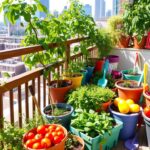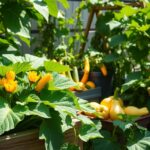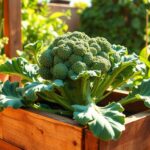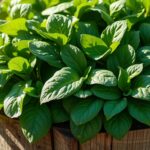Have you ever wondered why some plants thrive in small spaces while others struggle? The secret lies in understanding the unique needs of your green companions. Over the years, I’ve learned that creating a vibrant space with plants isn’t just about choosing the right ones—it’s about mastering the art of care.
When I first started, I made plenty of mistakes. Overwatering, poor soil choices, and neglecting drainage were just a few. But through trial and error, I discovered how to turn these challenges into successes. This guide is here to help you avoid those pitfalls and create a thriving environment for your plants.
From selecting the right soil to understanding watering routines, I’ll share practical tips that have worked for me. Whether you’re growing flowers, herbs, or leafy greens, these insights will help you make the most of your space. Let’s dive in and transform your small area into a lush, green haven.
Key Takeaways
- Choose the right soil mix for better drainage and nutrient availability.
- Water plants 2-3 times more frequently in small spaces.
- Use the “thriller, filler, spiller” method for visual appeal.
- Opt for slow-release fertilizers to maintain plant health.
- Select plants that thrive in shade or partial sunlight.
Introduction to Container Gardening and Its Leafy Focus
When I first started growing plants in pots, I had no idea how transformative it could be. My journey began with a simple desire to add greenery to my small outdoor space. Over time, I learned that success in this type of gardening depends on careful planning and attention to detail.
My Personal Journey with Container Plants
My early experiments with potted plants were far from perfect. I often chose the wrong pot size or overlooked the importance of proper drainage. But with time, I discovered that the right soil mix and consistent watering routines made all the difference. My interest in leafy varieties, like lettuce and spinach, grew as I saw how well they thrived in pots.
One of my biggest lessons was the value of selecting the right pot. Terracotta pots, for example, are great for drainage but require more frequent watering. Plastic containers, on the other hand, retain moisture better but need careful monitoring to avoid overwatering.
Overview of the Guide
This guide is designed to help you avoid the mistakes I made and create a thriving space for your plants. Here’s what you’ll learn:
- Pot Selection: How to choose the right size and material for your plants.
- Soil Mixes: The importance of using high-quality potting soil for better growth.
- Watering Techniques: Tips to ensure your plants get the right amount of water.
- Plant Choices: Recommendations for leafy varieties that thrive in pots.
By the end of this guide, you’ll have the knowledge to create a beautiful and functional garden, even in limited spaces. Let’s get started!
| Key Factor | Importance |
|---|---|
| Pot Size | Ensures adequate root space |
| Soil Quality | Provides essential nutrients |
| Watering Routine | Prevents over or under-watering |
Common Mistakes and Challenges in Container Gardening
Many gardeners face unexpected challenges when starting with potted plants. While the idea of growing plants in pots seems simple, it’s easy to make mistakes that can hinder their growth. I’ve learned through trial and error that understanding these pitfalls is key to success.
Identifying and Avoiding Frequent Errors
One of the most common mistakes is overwatering. It’s easy to think that more water means healthier plants, but this isn’t true. Overwatering can lead to root rot, which damages the plant’s ability to absorb nutrients. Crispy, brown leaves are often a sign of this issue.
Another frequent error is choosing the wrong pot size. A pot that’s too small can restrict root growth, while one that’s too large can hold excess water. Always consider the mature size of your plant when selecting a pot.
Understanding Disadvantages Like Overwatering and Leaf Scorch
Leaf scorch is another challenge that many gardeners encounter. This happens when plants are exposed to too much direct sunlight or extreme temperatures. Brown tips on leaves are a clear indicator of this problem. To prevent it, place your pots in areas with partial shade, especially during the hottest parts of the day.
Poor drainage is another issue that can compromise plant health. Without proper drainage, water accumulates at the bottom of the pot, leading to soggy soil and root damage. Always ensure your pots have adequate drainage holes.
By addressing these common mistakes, you can create a healthier environment for your plants. In the next sections, I’ll share practical solutions to these challenges, helping you achieve a thriving container garden.
Choosing the Right Foliage Plants and Containers
Creating a lush, vibrant space with plants starts with choosing the right foliage and containers. The combination of the two can transform any area into a green haven. I’ve learned that the key to success lies in selecting plants that thrive in pots and pairing them with containers that complement their needs.
Selecting the Best Foliage Varieties for Pots
When choosing plants for pots, I focus on texture, color, and adaptability. Some of my favorites include:
- Boston Fern: Its feathery fronds add a soft, elegant look and thrive in shaded areas.
- Coleus: Known for its vivid colors, coleus is perfect for adding a pop of brightness.
- Caladium: With its large, heart-shaped leaves, caladium brings a tropical feel to any space.
- Coral Bells: These plants offer a range of colors and are ideal for partial shade.
Each of these varieties brings something unique to the table, making them excellent choices for pots.
Optimal Container and Soil Considerations
The right pot can make or break your plant’s health. I always consider the size, material, and drainage when selecting a container. For example, terracotta pots are great for drainage but dry out quickly, while plastic pots retain moisture better.
Soil is equally important. I recommend using a high-quality potting mix that retains moisture while allowing for proper drainage. Adding compost to the mix can enhance nutrient retention and support healthy growth.
“The right combination of plant and container is the foundation of a thriving garden.”
When pairing plants with pots, I also think about aesthetics. A tall, dramatic plant like caladium looks stunning in a sleek, modern pot, while a cascading Boston fern pairs beautifully with a rustic ceramic container. By considering both function and style, you can create a visually appealing and healthy garden.
Watering Techniques and Leaf Health Management
Proper watering is the cornerstone of keeping your potted plants healthy and vibrant. Over the years, I’ve learned that maintaining the right balance of moisture is essential for preventing issues like root rot or leaf scorch. Let’s dive into practical tips to help you master this crucial aspect of plant care.

How Often to Water and Signs of Overwatering
One of the most common questions I get is, “How often should I water my plants?” The answer depends on several factors, including the type of plant, pot size, and weather conditions. For example, lettuce in smaller pots may need watering daily during hot summer months, while larger pots can go 2-3 days between waterings.
Signs of overwatering include yellowing leaves, soggy soil, and a musty smell. If you notice these symptoms, reduce watering frequency and ensure your pot has proper drainage. Checking the top inch of soil before watering is a simple yet effective way to avoid overwatering.
Dealing with Brown Tips, Dead Leaves, and Leaf Scorch
Brown tips on leaves are often a sign of inconsistent watering or low humidity. While it’s tempting to cut them off, I recommend trimming only the damaged parts to avoid stressing the plant. Dead leaves, on the other hand, should be removed promptly to prevent mold or pests.
Leaf scorch, characterized by crispy edges, is usually caused by excessive sunlight or heat. Moving your pots to a shaded area during peak hours can help. Additionally, monitoring soil moisture levels ensures your plants stay hydrated without becoming waterlogged.
| Issue | Solution |
|---|---|
| Overwatering | Reduce frequency, improve drainage |
| Brown Tips | Trim damaged parts, adjust watering |
| Leaf Scorch | Move to shade, monitor moisture |
By following these tips, you can maintain healthy, vibrant plants in your pots. Remember, consistency is key—whether it’s watering routines or monitoring for signs of stress. With a little attention, your plants will thrive and bring life to any space.
Troubleshooting and Resolving Common Plant Issues
Dealing with plant issues can feel overwhelming, but understanding the root cause makes all the difference. Over the years, I’ve encountered my fair share of problems, from root rot to crown rot. The key is to act quickly and use effective treatments to restore your plant’s health.
Recognizing Root Rot and Crown Rot in Container Plants
Root rot and crown rot are two of the most common issues I’ve faced. Root rot often starts with yellowing leaves and a foul smell from the soil. Crown rot, on the other hand, affects the base of the plant, causing it to turn mushy and brown.
Both problems are usually caused by overwatering or poor drainage. I’ve learned that inspecting the roots regularly is crucial. Healthy roots are firm and white, while rotting roots are soft and dark.
Effective Treatments: Cinnamon, Hydrogen Peroxide, and Repotting
When I first discovered root rot, I was unsure how to treat it. Over time, I found that cinnamon works wonders as a natural fungicide. Simply dusting it on the affected areas can prevent further spread.
Hydrogen peroxide is another effective solution. I mix one part peroxide with three parts water and apply it to the soil. This helps kill harmful bacteria and aerates the roots.
In severe cases, repotting is the best option. I remove the plant, trim the damaged roots, and place it in fresh, well-draining soil. This gives the plant a fresh start and prevents future issues.
“Early detection and quick action are the keys to saving your plants from rot.”
Fungus gnats are often a sign of deeper problems like root rot. These tiny pests thrive in damp soil, so addressing overwatering is essential. I’ve found that a diluted hydrogen peroxide solution can eliminate gnats and improve soil health.
Prevention is always better than cure. By maintaining proper watering habits and ensuring good drainage, you can minimize the risk of rot and keep your plants thriving.
Expert Leaf Container Gardening Strategies
Taking your plant care to the next level requires mastering advanced strategies to keep your green space thriving. From preventing pests to optimizing soil health, these expert tips will help you maintain a vibrant and healthy environment for your plants.
Preventing Fungus Gnats and Soil Issues
Fungus gnats can quickly become a nuisance in your pots. These tiny pests thrive in damp soil, making overwatering a common cause. To detect them, look for small, flying insects around your plants or larvae in the soil.
If you suspect an infestation, there are several steps you can take. First, allow the soil to dry out between waterings. Fungus gnats hate dry conditions, so this simple step can deter them. For a natural remedy, sprinkle cinnamon on the soil surface. Cinnamon acts as a fungicide and repels gnats effectively.
In severe cases, consider replacing the infested soil. While it may seem drastic, fresh soil can eliminate the problem entirely. Alternatively, treat the soil with a hydrogen peroxide solution to kill larvae and aerate the roots.
Enhancing Plant Health with Expert Tips
Healthy soil is the foundation of a thriving garden. I recommend using a high-quality potting mix that retains moisture while allowing proper drainage. Adding compost or pine bark can improve nutrient retention and support robust growth.
Regular inspections are crucial for early pest detection. Check the soil and roots for signs of rot or damage. Healthy roots are firm and white, while rotting roots are soft and dark. If you notice issues, act quickly to prevent further damage.
Here are some additional tips to keep your plants in top shape:
- Monitor Watering: Adjust your routine based on the season and plant needs.
- Use Natural Repellents: Cinnamon, neem oil, and diatomaceous earth are effective against pests.
- Clean Your Pots: Regularly wash containers to remove debris and prevent infestations.
“Proactive care and quick action are the keys to maintaining a healthy and pest-free garden.”
| Issue | Solution |
|---|---|
| Fungus Gnats | Dry soil, cinnamon, hydrogen peroxide |
| Root Rot | Repot with fresh soil, trim damaged roots |
| Leaf Scorch | Move to shade, monitor moisture levels |
By following these strategies, you can create a thriving environment for your plants. Whether you’re growing lettuce or other leafy varieties, these expert tips will help you achieve long-term success.
Conclusion
Mastering the art of growing plants in limited spaces has been a rewarding journey for me. Throughout this guide, I’ve shared practical tips to help you avoid common pitfalls and create a thriving environment for your plants. From selecting the right pot and soil to understanding proper watering techniques, these strategies are designed to make your experience easier and more enjoyable.
Remember, the key to success lies in proactive care. Watch for signs of stress like brown tips or leaf scorch, and act quickly to address issues like root rot. Choosing the right type of foliage, such as lettuce or plants that thrive in shade, can make a significant difference in your results.
I encourage you to experiment with these techniques and refine them based on your unique space and preferences. With consistency and attention, you can transform any area into a lush, vibrant haven. Thank you for joining me on this journey—I’m excited to hear about your successes and answer any questions along the way!




